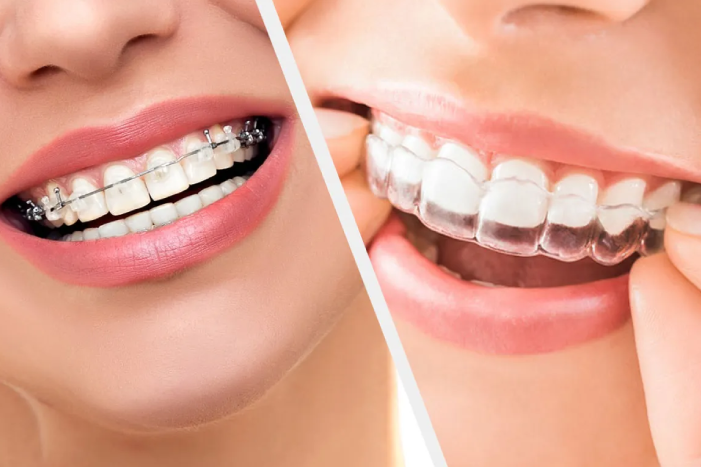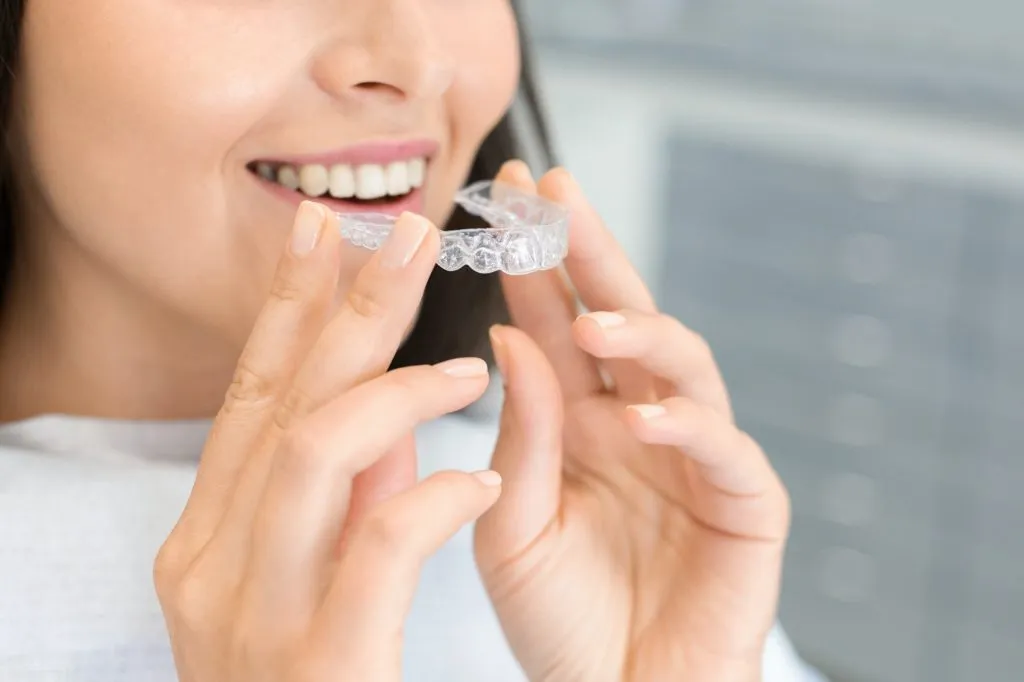
If you’re thinking about straightening your teeth, you’ve probably heard of both Invisalign and traditional braces. But how do you know which option is right for you?
The decision between Invisalign vs braces can feel overwhelming, especially when you’re unsure of the differences, benefits, and potential outcomes. Luckily, we’re here to help you understand these options in detail and make an informed choice.
At Leila Hariri Dental Clinic (LHDM), we offer both Invisalign and braces as part of our comprehensive orthodontic treatments.
Our goal is to guide you through the decision-making process, so you can feel confident about your path to a healthier, more beautiful smile.
What Are Braces?
Traditional braces are a well-known and highly effective method for correcting a wide range of dental issues. They consist of metal brackets that are glued to the teeth and connected by wires. These wires are gradually tightened over time to move the teeth into the desired position.
Braces are a tried-and-true method that has been used for decades to address various dental problems, including crooked teeth, gaps, and alignment issues like overbites and underbites.
What Is Invisalign?
Invisalign is a newer, more modern approach to straightening teeth. Instead of using metal brackets and wires, Invisalign uses a series of custom-made, clear plastic aligners that fit over your teeth. These aligners are removable and are designed to gradually move your teeth into their ideal position, similar to braces.
One of the major appeals of Invisalign is its virtually invisible appearance, making it a popular choice for adults and teens who want a more discreet orthodontic solution.

Invisalign vs Braces: How Do They Work?
Although both Invisalign and braces aim to straighten your teeth, they work in different ways:
- Braces use a system of metal brackets, wires, and rubber bands to apply continuous pressure to your teeth, gradually shifting them into place. The dentist or orthodontist adjusts the wires regularly, which tightens the braces and helps move your teeth into their new position.
- Invisalign relies on a series of clear aligners, each slightly different from the previous one. You wear each set of aligners for about two weeks before moving on to the next. Over time, these aligners move your teeth step by step toward their proper position.
At Leila Hariri Dental Clinic, both options are available, and we will help you choose the treatment that best fits your needs.
Invisalign vs Braces: Which Is Better for Overbite?
If you’re dealing with an overbite, you might be wondering which treatment braces vs Invisalign for overbite—will provide better results. The good news is that both options can effectively treat overbites, but there are some differences to consider.
- Braces have traditionally been the go-to treatment for more severe overbites. The combination of metal brackets and wires allows for precise control of tooth movement, and orthodontists can use additional attachments like rubber bands to help correct bite alignment.
- Invisalign can also treat overbites, especially mild to moderate cases. With Invisalign, the clear aligners are designed to gradually move your teeth into the correct position, including adjusting your bite. However, in some cases of severe overbites, braces may be more effective due to their ability to apply stronger, more targeted forces.
At LHDM, we assess each patient individually. If your overbite is more complex, traditional braces might be the best choice. But if your case is mild to moderate and you prefer a more discreet option, Invisalign may work just as well.
Invisalign vs Braces: Which Is More Comfortable?
When it comes to comfort, many patients find Invisalign to be the more comfortable option. The clear aligners are smooth and custom-fitted to your teeth, reducing the chances of irritation to the inside of your mouth.
Braces, on the other hand, can cause some discomfort, particularly in the first few days after they are tightened. The metal brackets and wires can sometimes rub against your cheeks and gums, causing soreness or even small cuts. However, orthodontic wax can help alleviate some of this discomfort.
Another advantage of Invisalign is that it’s removable, meaning you can take it out while eating or brushing your teeth. Braces, by contrast, are fixed, so you’ll need to take extra care to clean around the brackets and wires to avoid plaque buildup and cavities.
At Leila Hariri Dental Clinic, we prioritize patient comfort and will provide tips and advice to make your orthodontic treatment as smooth as possible, no matter which option you choose.

Invisalign vs Braces: Which Is More Convenient?
One of the main selling points of Invisalign is the convenience it offers. Since the aligners are removable, you don’t have to worry about food restrictions. With braces, you’ll need to avoid certain foods like sticky candies, popcorn, and hard foods that could damage the wires or brackets.
However, Invisalign requires a high level of responsibility. You need to wear the aligners for at least 20 to 22 hours a day to ensure that the treatment progresses as planned. If you forget to wear them consistently, it could delay your progress.
Braces, on the other hand, are always working because they’re fixed in place. You don’t have to remember to wear them—they’re doing their job 24/7. But this also means you’ll need to be diligent about oral hygiene, since it’s easier for food to get stuck in the wires and brackets.
Both options require regular visits to your dentist or orthodontist for adjustments and check-ups. With braces, you’ll typically need to visit every 4-6 weeks for adjustments. With Invisalign, visits may be less frequent, but you’ll need to change aligners every 1-2 weeks.
Invisalign vs Braces: Which is Faster?
In general, Invisalign and braces both take about the same amount of time to achieve the desired results. The exact duration of treatment depends on the complexity of your dental issues. On average:
- Braces treatments can last anywhere from 18 months to 3 years, depending on the severity of your case.
- Invisalign treatment usually takes about 12 to 18 months, although it can take longer for more complex cases.
While Invisalign can sometimes be faster, especially for less severe alignment issues, it’s important to note that sticking to the treatment plan is essential for both options. With Invisalign, you need to wear the aligners as instructed to keep your progress on track.
Invisalign vs Braces: Which Is Better?
So, Invisalign vs braces which is better? The answer depends on your individual needs, lifestyle, and preferences.
- Choose Braces if: You have more complex alignment issues or if you’re concerned about forgetting to wear removable aligners. Braces are effective for treating a wide range of dental problems, including severe overbites, underbites, and crooked teeth.
- Choose Invisalign if: You want a more discreet, less noticeable option and are looking for convenience and comfort. Invisalign is a great choice for people with mild to moderate alignment issues who prefer the flexibility of removable aligners.
At Leila Hariri Dental Clinic, we’ll work with you to determine the best treatment plan for your specific dental needs. Whether you choose Invisalign or braces, you can trust that you’ll receive expert care from our experienced team.
Conclusion
Deciding between Invisalign vs braces doesn’t have to be stressful. Both options are highly effective at straightening teeth and improving your smile. The key is to consider your lifestyle, the severity of your dental issues, and your personal preferences.
At Leila Hariri Dental Clinic (LHDM), we’re committed to helping you achieve the smile you’ve always wanted. Contact us today to schedule a consultation and find out which treatment Invisalign or braces is the best fit for you. No matter your choice, you’ll be on your way to a healthier, more confident smile!


